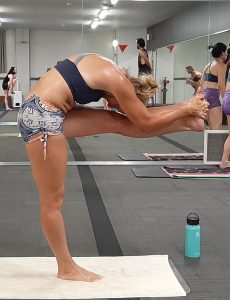
How many times in class do you hear the teacher shouting “Lock the Knee, lock the knee, lock the knee!!”?
Locking the Knee is possibly one of the most misunderstood principles in Bikram Yoga. In this blog, we’ll unlock (no pun intended) some of the myths by explaining why locking the knee is so important.
First let’s clear one thing up. What it is NOT. Locking the knee is NOT jamming your knee back as far as you can and trying to balance on it.
Physically, when you “lock your knee” in a balancing posture in Bikram Yoga, you are contracting your quadriceps muscles in the front of your leg, and therefore releasing the hamstring sending the message via the nervous system for it to stretch.
In the beginning this may feel uncomfortable, even painful because the nerves are not used to the stretch and will send pain messages to the brain. Our first impulse is to pull back, to avoid pain at all costs. However, if you want to improve stretch tolerance i.e. get more flexible, you may need to take the stretch to a point of pain. “Pain kills the pain”. This is not to say that you should be in tears, gritting your teeth and holding your breath but if you don’t take a stretch to a point of pain, you are not likely overloading your nervous system well enough to improve stretch tolerance, to get more flexible!
A key principle in Bikram Yoga is that you are trying to overload the nervous system to increase your stretch tolerance. That is how you become more flexible, decrease the risk of injury and relax your nervous system so that it is less sensitive and therefore your body will stretch.
Put simply, the only way to improve your flexibility is to improve the function of your nervous system. You’ll notice that when you are concentrating on locking the knee, you are less likely to fall out of the pose. Why, because you ARE concentrating!
What does Locking the knee look like?

You know you are locking your knee when you see your kneecap raise and muscles bunched above the knee, this indicates that the quadriceps muscles are being contracted.
There are 4 muscles in the quadricep femoris muscle group in the front of your leg. The one that is hardest to “turn on” is the vastus medialis obliquus (VMO) on the inside of the leg just above the knee. Its job is to extend the length of the thigh and to stabilize the patella (knee cap) so your knee tracks correctly.
The VMO muscle is a common centre of weakness in many people because it will not become fully strengthened unless the leg is regularly extended fully. It becomes more fully activated when the knee is at a greater angle, especially when the leg is completely extended.
As we age, the VMO muscle is the first muscle that we will start to lose. As it weakens this can bring problems with the knee, surrounding structure and cause chronic aching pain.
The good news…
Locking the knee is a highly effective way of building your VMO strength while also building density as you are standing and weight loading at the same time. And, you are completely normal if you find locking the knee very hard. It is hard. That is why you must CONCENTRATE to try to do it. This is how concentration improves your physical health!
The struggle in your mind as you try to keep the knee locked instills discipline. Learning discipline in the room helps us apply discipline in our lives. Ultimately, how we apply ourselves to the job of locking the knee is a metaphor to how we apply ourselves to the job of living.
